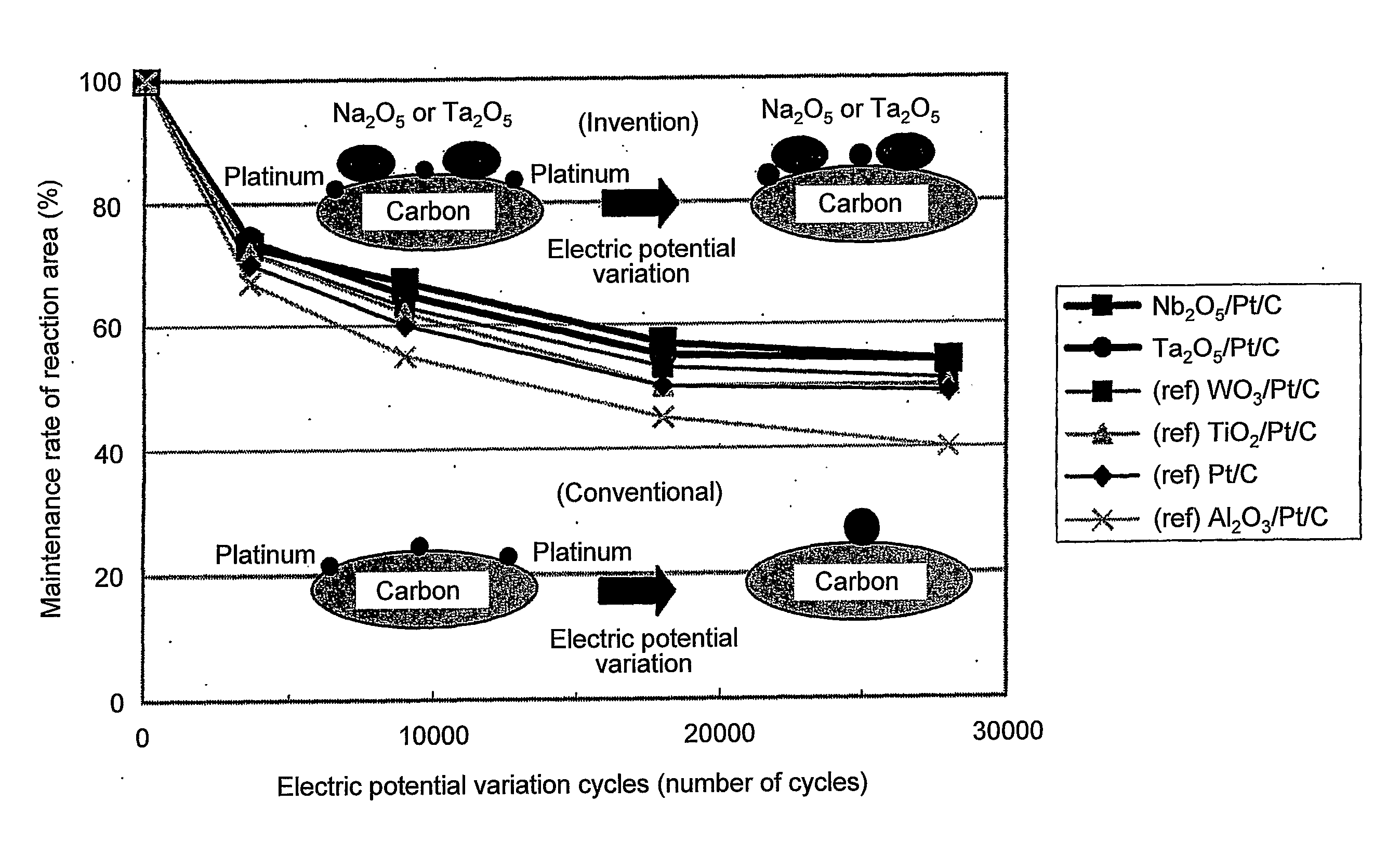Fuel cell catalyst, fuel cell cathode and polymer electrolyte fuel cell including the same
a fuel cell and catalyst technology, applied in the direction of fuel cells, fuel cells, cell components, etc., can solve the problems that the reaction area of the metal catalyst and the performance degradation of the fuel cell are not necessarily effective in preventing the sintering of the fuel cell electrode catalyst, so as to achieve the reduction of the reaction area of the metal catalyst and the performance degradation of the fuel cell, the effect of high power generation performance and high durability
- Summary
- Abstract
- Description
- Claims
- Application Information
AI Technical Summary
Benefits of technology
Problems solved by technology
Method used
Image
Examples
example 1
[0030]A Nb2O5 (30 wt %) / Pt / C catalyst was prepared according to the following procedures, an MEA was fabricated and the MEA was assembled to the cell, and then performance was evaluated.
(1) A mixture Pt (45 wt %) / C was suspended in purified water.
(2) A predetermined amount of NbCl3 was dissolved in purified water and stirred for 2 hours.
(3) Under stirring, a reducing agent such as aqueous ammonia was added dropwise until a precipitate was produced.
(4) A 2-hour stirring was made.
(5) Centrifugal separation, washing with water and filtration were carried out.
(6) Drying in an inert gas atmosphere was carried out at 80° C. for 6 hours.
(7) The dried product was allowed to stand in the air for about 12 hours.
(8) A predetermined amount of the thus obtained Nb2O5 (30 wt %) / Pt / C catalyst was mixed with a mixture composed of purified water, an electrolyte solution (Nafion: trade name), ethanol and polyethylene glycol (Nafion / Carbon=1.0 wt %) to prepare a catalyst ink.
(9) The catalyst ink was c...
example 2
[0031]A Ta2O5 (30 wt %) / Pt / C catalyst was prepared according to the following procedures, an MEA was fabricated and the MEA was assembled to the cell, and then performance was evaluated.
(1) A mixture Pt (45 wt %) / C was suspended in purified water.
(2) A predetermined amount of TaCl5 was dissolved in purified water and stirred for 2 hours.
(3) Under stirring, a reducing agent such as aqueous ammonia was added dropwise until a precipitate was produced.
(4) A 2-hour stirring was made.
(5) Centrifugal separation, washing with water and filtration were carried out.
(6) Drying in an inert gas atmosphere was carried out at 80° C. for 6 hours.
(7) The dried product was allowed to stand in the air for about 12 hours.
(8) A predetermined amount of the thus obtained Ta2O5 (30 wt %) / Pt / C catalyst was mixed with a mixture composed of purified water, an electrolyte solution (Nafion: trade name), ethanol and polyethylene glycol (Nafion / Carbon=1.0 wt %) to prepare a catalyst ink.
(9) The catalyst ink was c...
PUM
| Property | Measurement | Unit |
|---|---|---|
| voltage | aaaaa | aaaaa |
| specific surface area | aaaaa | aaaaa |
| thickness | aaaaa | aaaaa |
Abstract
Description
Claims
Application Information
 Login to View More
Login to View More - R&D
- Intellectual Property
- Life Sciences
- Materials
- Tech Scout
- Unparalleled Data Quality
- Higher Quality Content
- 60% Fewer Hallucinations
Browse by: Latest US Patents, China's latest patents, Technical Efficacy Thesaurus, Application Domain, Technology Topic, Popular Technical Reports.
© 2025 PatSnap. All rights reserved.Legal|Privacy policy|Modern Slavery Act Transparency Statement|Sitemap|About US| Contact US: help@patsnap.com



